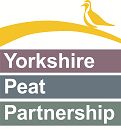The works at Oughtershaw and Fleet Moss, which commenced in March, 2019, are being carried out by Yorkshire Wildlife Trust through Yorkshire Peat Partnership (YPP), and the Pennine PeatLIFE project. They will restore 160 hectares of blanket bog on the watershed between the Ure and Wharfe catchments.
The once green, quaking blanket bog habitat is badly eroded by gullies and scarred with bare, exposed peat. In this state, thousands of years of stored carbon is escaping into the atmosphere and being washed off into waterways.
Julian Smith said:
“I really enjoyed seeing the work taking place at Oughtershaw and Fleet Moss during my visit, and meeting the team who are carrying out this fascinating project. This is exactly the kind of innovative, longer-term approach to environmental management that the Government is supporting through our 25 Year Plan for the Environment and I was glad to see the positive impact first-hand.”
Pennine PeatLIFE Project Officer, Jenny Sharman said:
“We’ve started damming the major gullies and replanting the bare peat. It’s thrilling to see how quickly restoration can have an impact. The coir dams are already holding back water and retaining peat sediment on the moors, where it should be.
”The cottongrass we planted is flourishing. Once it’s covering the bare peat, it will help to slow the flow of rainfall across the moor and that will help to manage flooding downstream.”
The work is funded by Pennine PeatLIFE and DEFRA, and delivered on the ground by Yorkshire Wildlife Trust and Marsden AES contractors.
Yorkshire Wildlife Trust’s Peat Programme Manager, Tim Thom, said:
“As well as natural flood management and carbon storage, healthy peatlands are amazing habitats for extraordinary wildlife and they’re beautiful places to visit.
“Despite the progress we’re making on this site, restoring peatlands is a long term process, and needs a long-term outlook with corresponding long-term policies and funding. Peatland restoration is ideally suited to the Government’s 25-year Environment Plan.”
